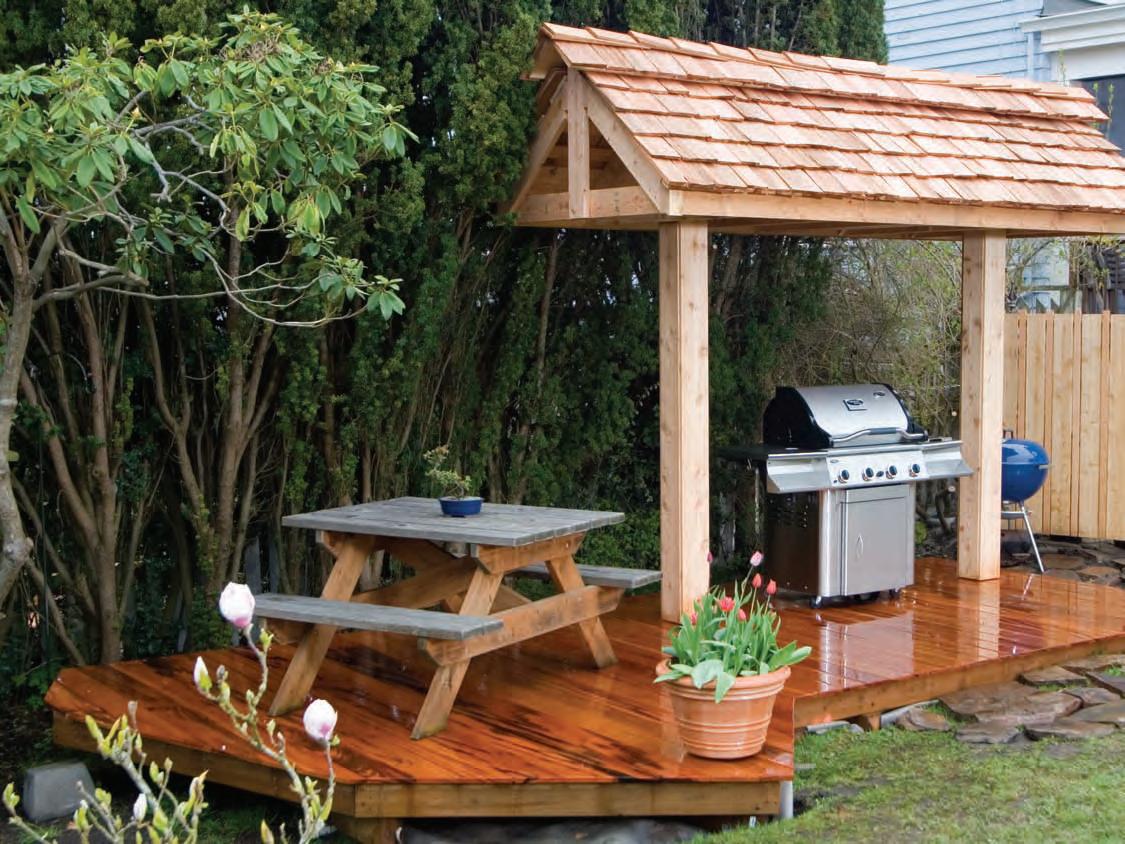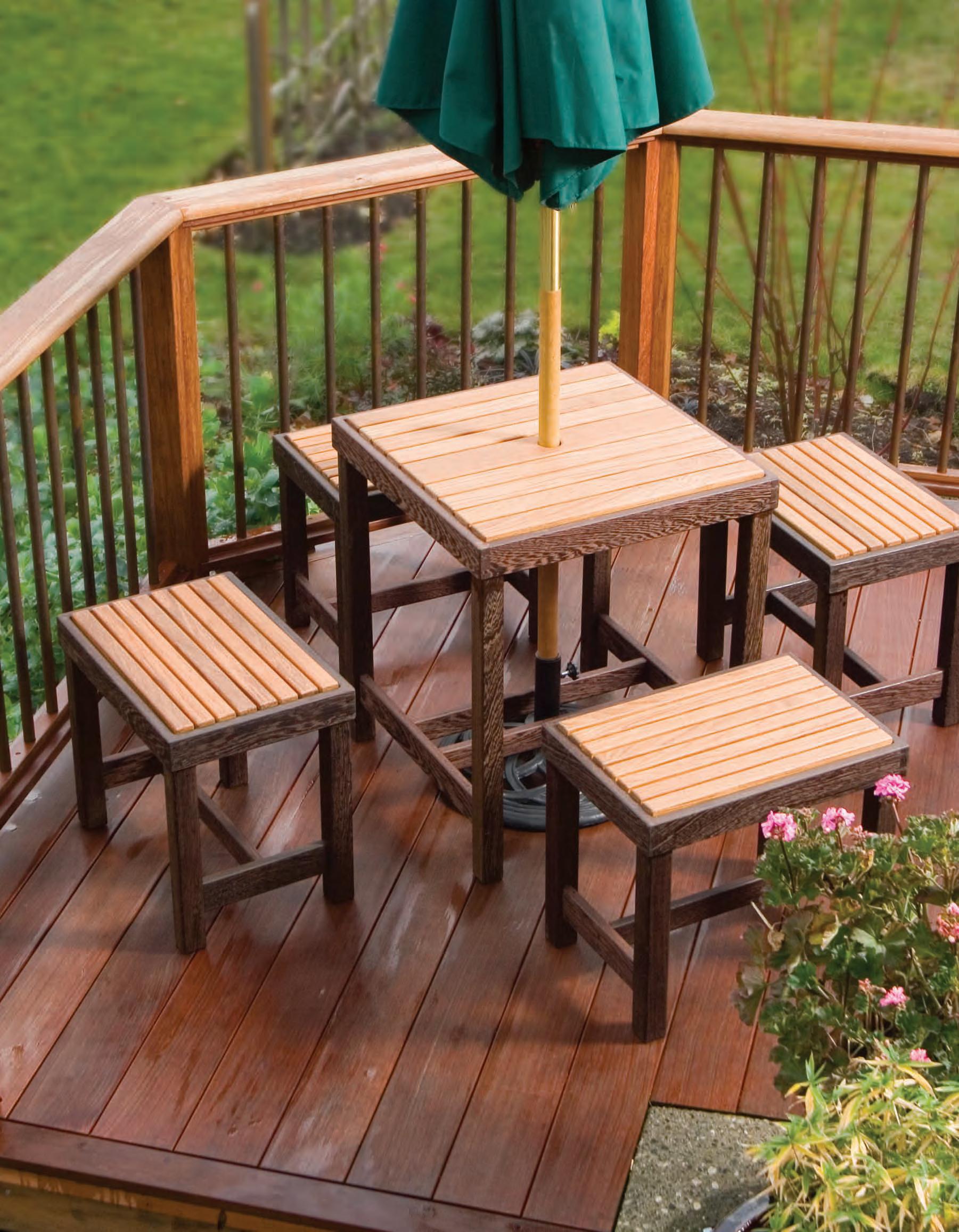Wooden Projects Wooden Projects for Outdoor Living Beautiful

 JOHN MARCKWORTH
JOHN MARCKWORTH



 JOHN MARCKWORTH
JOHN MARCKWORTH

A favorite landscape design feature of my backyard is a small, compact deck. It’s a great place to hang out with a beverage, but the low square footage is easily overwhelmed by a traditional garden table and four chairs. My solution to this problem was to develop a design for a small table and four bench seats that could be arranged in different seating configurations or moved out of the way completely if necessary. They also function nicely as side tables for lawn chairs and are sturdy enough to stand on to retrieve the cat from lower tree branches.
I chose to use teak for the tops and wenge for the frames and legs. The wenge was an experiment. It’s a durable tropical hardwood and, when oiled, provides a striking contrast to the lighter teak.
I made all four benches as a single production run. This not only made the construction process faster and more efficient but also ensured that component sizing and dimensions were exactly the same for all of the benches. Although the measurements are different, I also made the table part of the production run, utilizing the same machine setups for the different steps.



inches (millimeters)


REFERENCE QUANTITY PART STOCK COMMENTS



(mm) (mm) (mm) LENGTH WIDTH THICKNESS
A 2 apron sides wenge 3 ⁄ 4 (19) 21 ⁄ 2 (64) 20 (508)
B 2 apron ends wenge 3 ⁄ 4 (19) 21 ⁄ 2 (64) 14 (356)
C 4 legs wenge 13 ⁄ 4 (45) 13 ⁄ 4 (45) 165 ⁄ 8 (422)
D 2 leg cross braces wenge 3 ⁄ 4 (19) 21 ⁄ 2 (64) 10 (254)
E 1 stretcher wenge 3 ⁄ 4 (19) 2 (51) 15 (381)
F 8 top slats teak 3 ⁄ 4 (19) 13 ⁄ 8 (35) 181 ⁄ 8 (460) 3 ⁄ 16 16" + ⁄ (5mm) between slats and between the slats, apron sides and ends
G 2 top slat cleats wenge 5 8 (16) 3 ⁄ 4 (19) 121 ⁄ 2 (318)
TECH tip
UTTING LIST bench seat ( this is for one sea t )

4After
After applying glue to the dovetail pins and tails with a small brush, assemble the apron using bar clamps. Although the dovetail joints do a good preliminary job of squaring the assembly, carefully equalize opposing corner-to-corner measurements.







Much of the strength of the bench seat results from way that the legs are attached to the apron corners. Each leg has a shoulder cut into the tops of two adjacent sides and a corner of the apron rests on these shoulders. This design provides solid support for the apron-and-top assembly to supplement the mechanical fasteners. After cutting the legs to length, mark the faces to be cut with chalk. This helps keep track of the cutting sequence and prevents cutting errors.
No matter how carefully I make router dovetail cuts in hardwoods, there is inevitably a chance for “blowout” or chipping when the bit catches the edge of the wood grain. I’m not a fan of putty or wood dough fillers because the color is never the same as the wood, even with stain and it doesn’t hold up outdoors. I make my own filler using glue and sawdust from the wood I’m using. In this case I mixed wenge sawdust with a dark-colored waterproof glue.
5 Make the crosscuts on the two marked adjacent sides on each leg.




To prevent stock from pinching against the fence and kicking back when you use the miter gauge, use a starter block. This is simply a scrap of wood clamped to the fence behind the leading edge of the blade. Adjust the fence so that the distance from the face of the block plus the blade kerf (in this case) equals the length of cut you need to make. With the stock held against the miter gauge, move it over to just touch the side of the block. Since the front edge of the block is behind the blade, the stock will be clear of both the fence and the block when the cut is made.
6 Finish the shoulder cuts on the band saw using a stop clamped to the table to limit the length of cut. 7 These legs are ready for assembly.











So no fasteners will show on the finished bench top, attach the slats from below. With the slats and spacers set loosely in place on the cleats, lay a piece of 1 ⁄ 4" (6mm) plywood (slightly larger than the bench) over the top, then flip the entire assembly upside down on your work surface. If you’re careful, the slats and spacers will all stay together inside the apron, ready for installation! Predrill into the slats through the cleats at each end and fasten the slats from below with screws. Attach a brace across the center of the slats from below with screws. Although probably not necessary, this brace adds stiffness and strength to the top slat assembly.
The table closely follows the design of the bench seats. The material, joinery and construction sequences are exactly the same; only sizing and dimensions are different. The table is square and the top has a center hole for a


patio umbrella. The design of the top slats, slat supports and stretchers have been modified to accommodate the umbrella and umbrella base, but those are the only structural differences.
(597)



1The bench seats have a single stretcher, but the table needs two — with enough space between them for the umbrella shaft and base. Using spacer blocks to hold the stretchers in position, attach the the stretcher with screws through the outside of the leg cross braces. Plug the screw holes.

As I said earlier, I like the contrast between the two woods I used for the benches and table. To protect against weathering and to keep the colors looking fresh, I applied a brush-on, wipe-off exterior oil sealer that I plan to reapply yearly.


The tabletop slats are proportionally wider than the bench seat slats. Make the center slat wider to accomodate the umbrella hole. Install two evenly-spaced teak braces below the slats for extra support.
